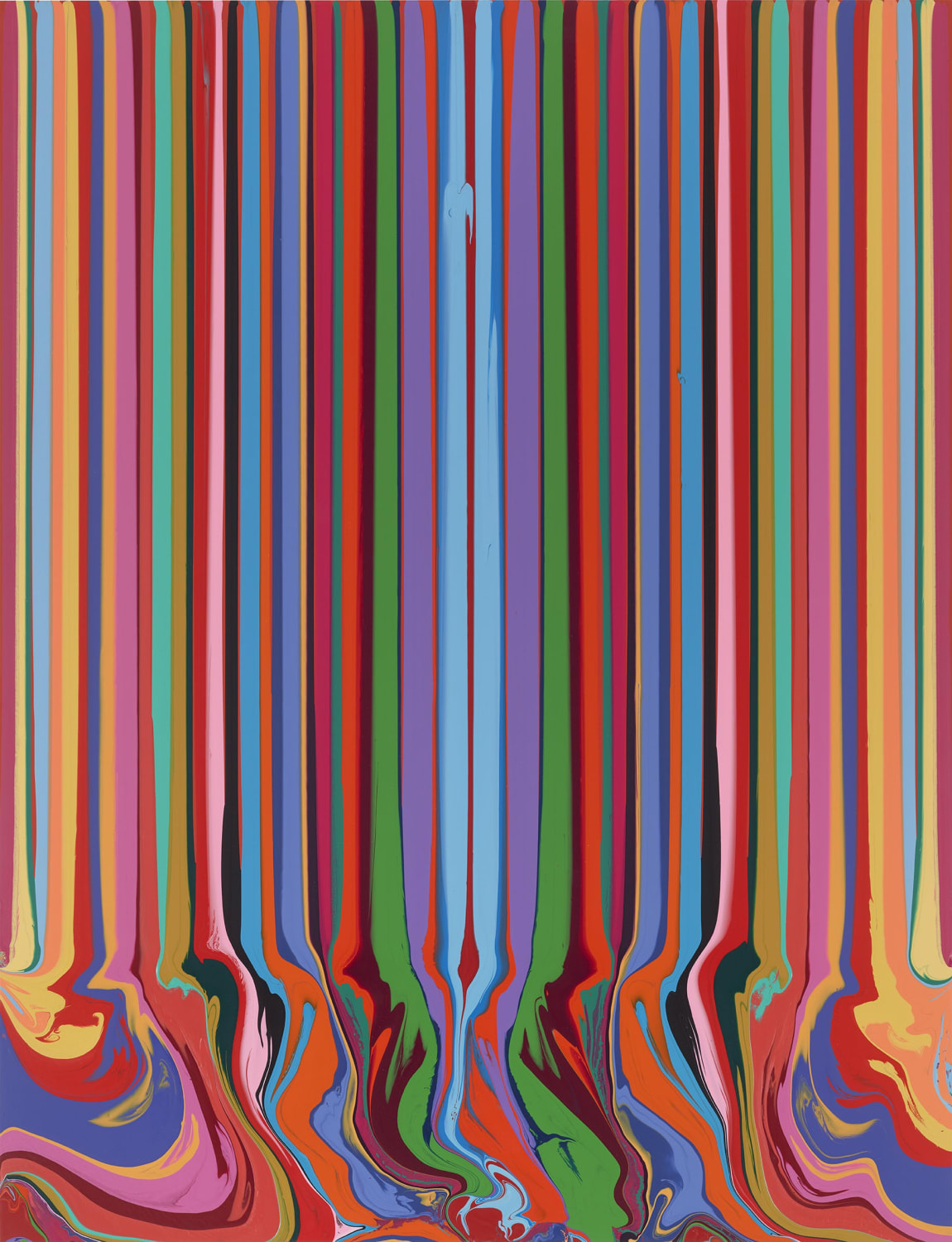Mirrors and Lights: Galerie Andres Thalmann
Bright, powerful lines of paint flow down an aluminium sheet in long vertical trails, creating a clean, dynamic pattern. The bottom edge of the aluminium “canvas” is slightly curved, allowing the colours to spread out here, intermingling and forming psychedelic puddles – and hence the images get their name: Puddle Paintings.
With his poured-line pictures, Ian Davenport has made a name for himself in the art world, developing a visual language all his own – one that is both unmistakable and yet also infinitely malleable. His Puddle Paintings are like a festival of colours, a clear yet cleverly composed ode to the joy of seeing and of art itself. But the works are much more than that. They are created through a process that recalls the meticulous work of a surgeon or scientist working with precision. In the case of Ian Davenport, it is a paint-filled syringe that he uses to apply his colours to the top edge of his aluminium sheet, from where they run straight down the length of the metallic backdrop, leaving vivid trails behind them.
It’s not only the syringe that links Ian Davenport to the scientific approach, but also his sense of curiosity. There is clearly an inquisitive spirit behind the stripes in his images. In one part of his previous œuvre, for example, the colour palette of his Puddle Paintings could be traced back to well-known works in art history, such as Édouard Manet’s Olympia (1863). The series of Puddle Paintings that arose from Davenport’s study of this particular modernist work will also be on display in the exhibition. His technique is grounded in an analysis of the specific colours they contain. Davenport isolates these colours and allowed them to flow down the metal sheet as stripes – and voilà, a completely new work of art was created.
In his current works, the artist has turned his gaze on society itself. Even the name he gave to this category of Mirrored Paintings already hints that they are addressing such themes as self-reflection and introspection, indeed representing a harkening back to the recent pandemic when many of us retreated into a quiet period of contemplation, questioning what was important in our lives.
By arranging these colours in a strictly symmetrical order, Davenport is subtly alluding to the passage of time, and to the sensitivities it evokes. A vertical centre line neatly divides the images into two halves, with the colour sequence on the right half exactly mirroring the one on the left. This symmetry creates a sense of calm, giving the images an appearance of focus and harmony, even though the colours themselves are vibrant and bold. In some instances (for example Red Centre, 2022), the symmetry in the centre of the image creates the impression of a closed curtain – one that could open at any moment, making room for new images, new experiences and new thoughts.
In 1991, at the tender age of 25, Ian Davenport was already nominated for the coveted Turner Prize. In his career, he has gained international recognition with numerous exhibitions and striking projects in public spaces. His current major project is the design of a staircase at the Chiostro del Bramante in Rome, consisting of luminous streams of colour flow – a unique marriage of Donato Bramante’s Renaissance architecture and Ian Davenport’s contemporary vision. This spectacular will be display in Rome until 8th January 2023.
Everything flows. The philosophical formula also applies to a new small-format series by the British artist, in which diagonal stripes undulate through the pictorial space as waves of paint. Small bubbles sit atop some of the waves of paint, like reflections of light or drops of sea spray. Titles of these works, such as Flow or Current, call to mind the element of water, and also the flows and movements taking place within us human beings: the emotions.
Playing an even more radical role in another new series, the element of movement dominates images where Davenport has splashed liquid paint head-on onto paper. This creates irregular, wildly distressed spots and tracks that are reminiscent of the drippings of Abstract Expressionism or graffiti signatures on the walls of our everyday urban streets. The titles are often taken from a firework glossary and the artist alludes to the exuberance of exploding colour. Ian Davenport began making images with this raw, explosive dynamic only a few years ago, working with different base colours, dark shades of grey, to express varying moods or “sounds”. The images created seem like snapshots of moments and states, capturing times of dark mental turmoil or moments of sparkling, vibrant dynamism and joie de vivre.
Alice Henkes

